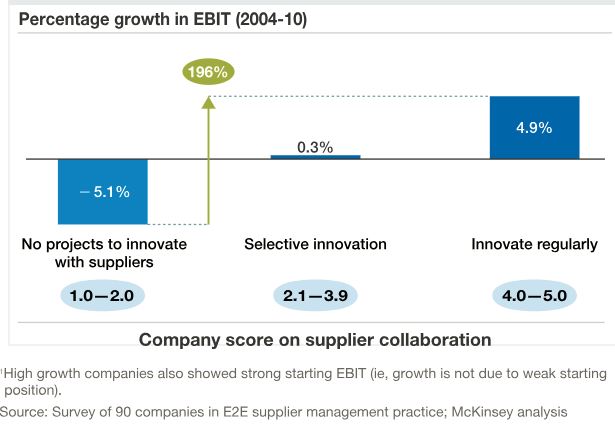What is supply chain collaboration anyway…?
I’ve learned that the term ‘supply chain collaboration’, is often a term that is used to say different things, or to present different opportunities. For discrete manufacturers, it is an important term that may have great implication on their success to produce complex products efficiently.
When I talk about ‘supply chain collaboration’ this is what I mean:
Extending the Digital Thread and the synchronization beyond the factory of the site itself, across the entire supply chain, to increase visibility and ensure on-time delivery of work orders. Factories, suppliers and distribution centers, can all be part of a single tracked chain, resulting in a new standard for manufacturing efficiency and uniformity across all production sites.
Important note: there’s lots of evidence that shows that in almost 50% of the cases, supply chain collaborations fail to deliver for different reasons, I will elaborate more later.
Why is supply chain collaboration so important to manufacturers and discrete manufacturers in particular?
Well to start with, in the past, many factories, not to mention entire production operations, were running under one roof or in a single site. Today, things look quite different with OEMs (Original Equipment Manufacturers) subcontracting major work to tier 1 suppliers who subcontract components and parts to tier 2 suppliers who in some cases pass jobs to tier 3 suppliers.
For instance, ChainLink Research found that manufacturing and logistics outsourcing has shown ‘Double-digit compound annual growth rates (CAGRs)’ in ‘many manufacturing outsourcing sectors.’- This is just one indication.
With the growing demand and accelerated globalization, it is only logical that supply chains became much more segregated, complex and multi-site in nature.
The common discrete manufacturing supply chain is no different. Discrete manufacturing involves a lot of different production companies, and they all need advanced collaboration tools in order to survive in today’s competitive arena.
Among the different kinds of collaborations, you can find collaboration in communication, execution, information and resources sharing, decision making, knowledge creation and so on.
Competitive Advantage is a Main Benefit
The benefits in supply-chain collaboration are significant; to name a few:
- On-time delivery of products – eliminates late delivery by identifying production delays early in the cycle
- Time saved – traces and logs assets while they move throughout the supply chain
- Improved quality and control – ensures uniformity across factories
- Security – enables safe transfer of information inside and outside the enterprise.
Still, if you ask manufacturers, they would say that the most important benefit is surviving in an ever growing competitive landscape and staying ahead of the game.
A lot of evidence clearly indicates that manufacturers that invest efforts in optimizing their supply-chain collaboration are much more likely to succeed in their business, than others that don’t. Ford sets a good example of this.
A McKinsey study dated all the way back to 2013 has found that ‘Companies that collaborate deeply with suppliers grow faster.’
Leveraging cloud, digitization, industry 4.0 and IIoT for supply chain collaboration
Every year, Gartner releases its top 25 Supply Chains, identifying supply chain leaders and highlighting their best practices. The 2017 winners were selected based on their ability to make their supply chains fully digital, as Gartner states:
‘The past few years have seen a massive shift in companies creating digital connections within and across their supply chain operations. Leading companies view digitalization as an opportunity to not only provide agile support for existing products, but to reduce time to market for new ones. Some of the most disruptive and impactful technologies include solutions combining Internet of Things (IoT) sensors, cloud computing and advanced analytics. Simulation and optimization capabilities have moved into the mainstream and now cognitive computing capabilities, including machine learning, are in the labs of the most advanced supply chains. The digital pieces of the supply chain puzzle are coming together in a way that will enable more holistic, real-time management of the entire ecosystem.’
2018 winners are continuing this trend and scaling their digital supply chain:
‘Scaling the most viable digital supply chain solutions in factories, warehouses and corporate back offices.’
Benefits of Supply Chain Collaboration in Discrete & Complex Manufacturing

Looking at discrete complex manufacturing, supply chain collaboration is even more important and critical. In these manufacturing ecosystems, many different tools, materials and processes are involved.
It’s not only about quantity. Most discrete manufacturers use ultra expensive tools and materials.
In discrete manufacturing, usually parts and components are accompanied by paperwork that is not fed to the digital systems used by the next supplier. A lot of valuable information is lost on the way, not to mention the lack of visibility regarding the status and progress of work orders. If you miss something significant due to lack of collaboration you could be facing a disaster that impacts the entire supply chain.
Supply Chain precision
Supply chain collaboration enhances precision in execution. Efficiency increases as each party in the supply chain is doing exactly what needs to be done and nothing besides what needs to be done. That is a completely different production strategy, as companies stop working by “batches”, but by instances, opportunities, demand or alike.
Without it, defects (that impact the whole chain) may be discovered late in the process, and human errors can go unnoticed, production includes a lot of paperwork (higher error potential) and the result is a less precise supply chain, hence delays, discoordination between demand and supply, reduced quality and so forth.
Think about a relay race – If parties are coordinated, harmony is gained and the result is optimal. Otherwise, each party is operating separately, overlapping in efforts will occur and the whole thing becomes a mess.
Supply chain precision is a key benefit of supply chain collaboration.
Centralized solution
When talking about supply chain collaboration in discrete complex manufacturing, having any solution that claims to offer some supply chain collaboration features may not be enough. Since the production and the supply processes are usually distributed among remote sites, and involve multiple vendors, a proper supply chain collaboration solution must offer full visibility over the work order status for each ‘value chain’ player: suppliers, manufacturers and customers.
Think of an automated process that relies on factory floor sensors in order to update the work order status and progress and then shares only relevant data with each player, in real time. This example of a solution is not something that is easy to create, but that’s the level of collaboration that may be needed in order to make things more efficient.
Of course, you could support some supply chain collaboration via file exchange and API extraction, but the ability to automatically and digitally share and receive an assets’ status as well as historical information when needed (bounded by authorization), in one place, is a whole different thing.
Recalls, People, Recalls
Recalls are not something to underestimate. In the automotive industry, for instance, recalls are pretty common. This is also the case in many other manufacturing industries.
How is this related here? Well, here’s an example: a supply chain collaboration that is efficient enough can support a quick monitoring process that traces back to the raw materials in order to find the exact location of the problem and fix it before the product is shipped to customers, in some cases, as soon as the quality problem arises.
Simply stated, an efficient supply chain collaboration can help manufacturers minimize recalls or manage them better, if they do happen.
The big Q – How much money will I save?

Some would say gaining visibility and traceability over products in discrete manufacturing industries is worth a fortune, although the volume of supply chain collaboration use cases is not yet high enough to establish reliable ROI benchmarks.
But there are some interesting use-cases; Boeing’s’ chief executive of Defense, Space and Security, Chris Chadwick, quantified their supply chain ROI: ‘Out of the $6 billion, probably 66 percent of that [cost cutting] will come out of the supply chain, maybe more.
According to University of Tennessee research: ‘OfficeMax collaborated with its supplier Avery Dennison to dramatically increase revenue by more than 22 percent, achieve product availability to more than 99 percent, significantly decrease inventory by 34 percent, and save more than $11 million in logistics costs. Whirlpool used a transformational strategy to deliver record-high service levels while decreasing inventory levels by over $100 million and logistics costs by $20 million.’
But, there are challenges…
Remember what I mentioned earlier about the failure ratio?
In the 2018 MHI Annual Industry Report, supply chain players recognized “trust and cyber-security concerns” as the biggest factor that is holding them back.
Though supply chain collaboration capabilities offer clear benefits for suppliers, many ecosystem players are just not there yet, as i-scoop describes it:
‘[…] there is still quite a lot of paper moving around in manufacturing and information sharing across the supply chain happens through good old email, EDI and fax, far from digital supply networks. In other words: the end-to-end smart chain with seamless information flows, let alone easy and fast access to critical information, de facto is far away for many.’
Indeed, there are some challenges standing in the way of the ‘digital supply chain’ let alone supply chain collaboration among multiple players. As mentioned above, there are a couple of main issues. Communication with other sites is paper-based, hence inefficient. Also, mistrust between industry players and a conflict of interest play a role. Furthermore, gaining visibility into suppliers’ order status and quality, as well as tracking asset movement between factories is a difficult to achieve task that demands a lot of setup and ongoing work resources.
And then there are risks…
One of the main risks that is often talked about is the security risk. The fear that data would be hacked is taking its toll and prevents manufacturers from collaborating with other supply chain players. You can address security issues by making sure your supply chain collaboration solution takes the necessary security steps.
Another risk is to invest a lot of effort into supply chain collaboration only for it to fail.
That’s a risk that people hate: the chance of failure. And since 47% of all supplier collaborations fail, this is something that you need to mitigate and plan in advance.
Failure might mean loss of time, communication overhead and waste of money and resources. Why do supply chains collaborations fail? There are multiple reasons.
One being that the struggle to manage the complexity of the new relationships and harmonizing processes across two [or more] distinct organizations can prove too difficult. Often, buyers simply lack the skills to establish the governance structure for these new partners.
How can I win this game?
First, management commitment is a must:
Getting a clear commitment from the entire organization is essential. I would also ensure their willingness to disrupt legacy work processes, as it will create some overhead during the onboarding process. A good tactic would be to present some ROI benchmarks and use cases, get everybody motivated and help not only C level but also low-level employees see the clear benefits as well.
Achieve internal collaboration:
Increasing evidence implies that multiple supply chain collaborations fail due to internal resistance. Simply put: Lack of internal collaboration and proper teamwork fail these initiatives. Whether the reason is an ‘old fashioned’ approach or employees threatened by the success of such a collaboration, success is highly dependent on the ongoing commitment of the team. I would recommend assigning the role of collaboration supervisor to someone on the team and get him (or her) working with the team on the processes and methods, projecting back to management on a weekly basis and ensuring that new team members are well trained on related processes and get the big picture.
Make sure that you have the right technology by your side:
You may find multiple Industry 4.0 solutions that claim to be tailored to support supply chain collaborations, but that claim is easier said than done. Some can support only partial collaborations; others won’t take the needed security steps to ensure full protection.
Some will not offer a ‘decision making’ support layer, hence missing the whole point of the endeavor.
Make sure to choose a solution that offers supply chain collaboration support through the entire thread, and alerts as much as needed as soon as demand changes are identified, there’s a projection for a lack of materials, shipment issues are identified and so forth. Make sure you select a solution that can be easily and feasibly implemented by your entire value chain members (considering their legacy solutions, sensors, machinery and so forth).
‘Supply-Chain-Collaboration’ solution
Assign the right stakeholders
Along with the right technology, I advise you to look for the right people who can successfully lead the process. Here’s your profile: Trained, experienced, knowledgeable, patient, visionary organized, project management guru, open-minded, agile and communicative professional. Good luck with that 🙂
Make sure there’s a detailed plan with work rules and KPI’s
Any process needs a plan and its own set of rules, let alone the one described here. Develop a plan that includes defined KPI’s and a road map of future things you want to invest your time and resources on.
And there are a bunch of other elements of a successful Supply Chain Collaboration:
PwC Strategy & Germany envision the following 8 elements of a successful supply chain (they call it becoming a “digital champion”) in their paper: integrated planning and execution, logistics visibility, Procurement 4.0, smart warehousing, efficient spare parts management, autonomous and B2C logistics, prescriptive supply chain analytics, and digital supply chain enablers. Of course, no supply chain meets all 8 to the fullest, but trying to can make all the difference between succeeding and failing:
Summary
A wise man once said that necessity is the mother of all inventions. Supply chain collaboration was invented to solve specific and burning needs.
It was raised to help manufacturers deal with the growing competition, growing quality standards and the growing production volume to fulfill market demands.
Supply chain collaborations depend on robust technology, but it was only recently that cloud solutions became mature enough for that sort of an innovation.
Digitizing your production and implementing an advanced IIoT platform is crucial for a successful and comprehensive supply chain collaboration.
















